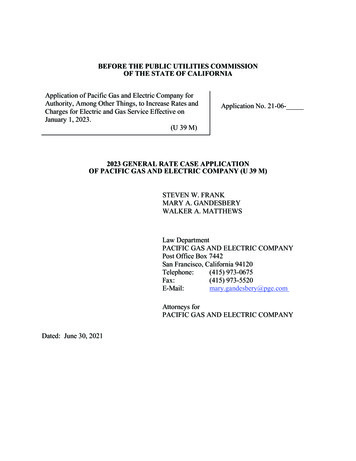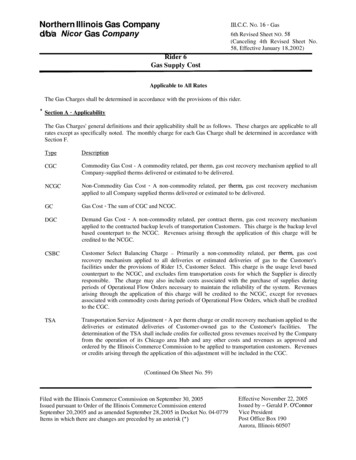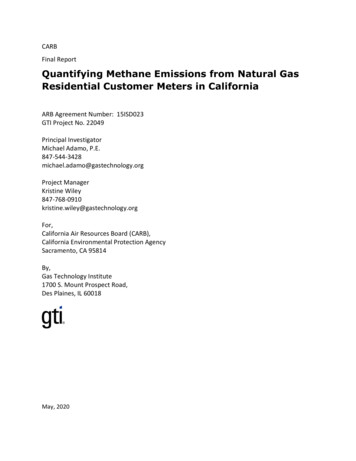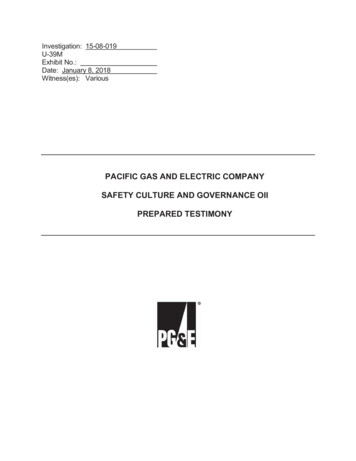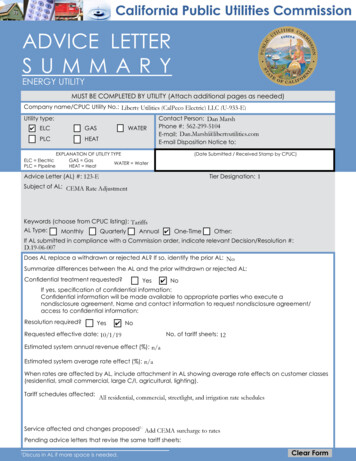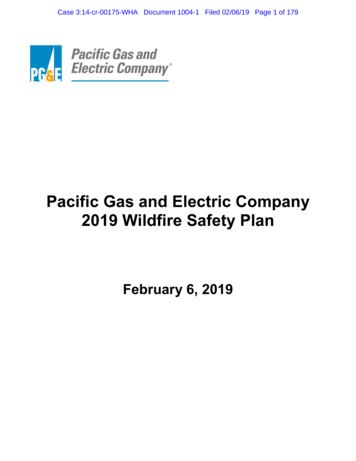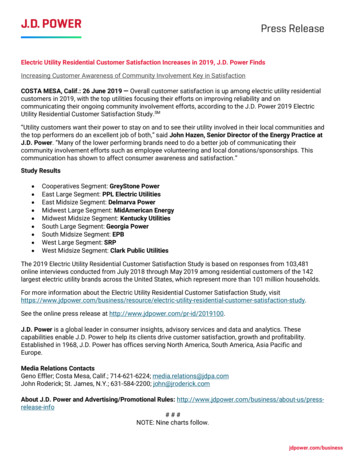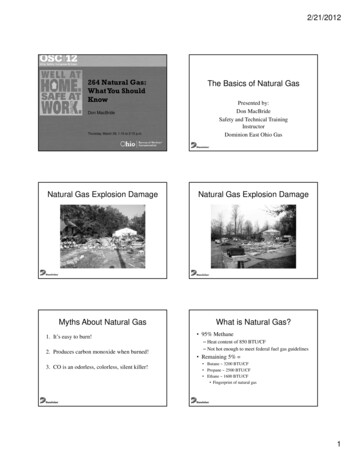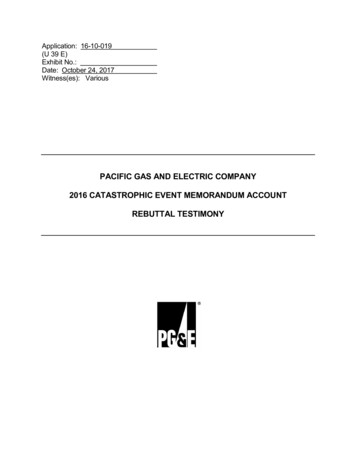
Transcription
Application: 16-10-019(U 39 E)Exhibit No.:Date: October 24, 2017Witness(es): VariousPACIFIC GAS AND ELECTRIC COMPANY2016 CATASTROPHIC EVENT MEMORANDUM ACCOUNTREBUTTAL TESTIMONY
PACIFIC GAS AND ELECTRIC COMPANY2016 CATASTROPHIC EVENT MEMORANDUM ACCOUNTREBUTTAL TESTIMONYTABLE OF CONTENTSChapter1Attachment ATitleWitnessINTRODUCTION AND SUMMARYMinci HanPG&E’S DISCOVERY RESPONSE TO TURNDATA REQUEST 4, QUESTION 12ELECTRIC DISTRIBUTION COSTS3DROUGHT-MITIGATION ACTIVITIES AND COSTS Niel Fischer4GAS DISTRIBUTION AND GAS TRANSMISSIONCOSTSMelvin J. Christopher5OVERHEAD COSTSJoseph M. MarshmanSTATEMENTS OF QUALIFICATIONSMinci HanJoseph M. MarshmanAppendix A-i-Angie M. Gibson
PACIFIC GAS AND ELECTRIC COMPANYCHAPTER 1REBUTTAL TESTIMONYINTRODUCTION AND SUMMARY
PACIFIC GAS AND ELECTRIC COMPANYCHAPTER 1REBUTTAL TESTIMONYINTRODUCTION AND SUMMARYTABLE OF CONTENTSA. Introduction. 1-1B. Summary of Updated Position . 1-1C. General Issues Raised by ORA and TURN . 1-21. ORA’s and TURN’s Recommendation to Disallow Straight-time LaborCosts Is Not Reasonable . 1-22. TURN’s Criticisms of PG&E’s Showing on Cost Reasonableness AreNot Justified . 1-7D. Organization of PG&E’s Rebuttal Testimony . 1-10E. Other Matters . 1-101-i
PACIFIC GAS AND ELECTRIC COMPANYCHAPTER 1REBUTTAL TESTIMONYINTRODUCTION AND SUMMARY12345A. Introduction6Q 1Please state your name and the purpose of this rebuttal testimony.7A 1My name is Minci Han and I am adopting Chapter 1 of the opening8testimony supporting Pacific Gas and Electric Company’s (PG&E or the9Company or the Utility) 2016 Catastrophic Event Memorandum Account10(CEMA) Application ((A.) 16-10-019). I am also sponsoring this rebuttal11testimony to respond to the straight-time and cost reasonableness12recommendations made by the Office of Ratepayer Advocates (ORA)1 and13The Utility Reform Network (TURN).214B. Summary of Updated Position15Q 2What is PG&E’s updated request for the 2016 CEMA application?16A 2PG&E’s updated request is a 145.8 million revenue requirement increase17which is proposed to be collected as follows: 139.8 million for 2018 and18 6.0 million for 2019. This is a reduction of approximately 1.4 million from19the 147.2 million in revenue requirement identified in PG&E’s October 31,202016 application. The updated request reflects concessions and corrections21made as part of PG&E’s rebuttal testimony. While PG&E has not re-run the22results of operations model, PG&E estimates that the revenue requirement23reduction associated with the corrections to be approximately 1.4 million.24Table 1-1 summarizes PG&E’s updated request in its 2016 CEMA25application.1Report on the Results of Examination for PG&E’s CEMA Regarding Events Occurringfrom December 2012 through March 2016.2Prepared Testimony of Robert Finkelstein on Application of PG&E for Recovery ofCEMA Costs (Finkelstein) and Report on PG&E’s CEMA Application (Sugar).1-1
TABLE 1-1UPDATED REVENUE REQUIREMENT SUMMARY(THOUSANDS OF NOMINAL DOLLARS)LineNo.12October 31, 2016 Application Request(a)Rebuttal Adjustments3Updated Request20182019Total 141,212(1,394) 6,006(1) 147,218(1,395) 139,818 6,005 145,823(a) See rebuttal testimony Chapter 2 for corrections associated with electric distributionemergency response and Chapter 4 for corrections associated with gas distributionemergency response. The overall reduction also includes two corrections: (1) areduction of 8,500 to remove the remaining vacation costs inadvertently included, asdescribed in PG&E’s response to ORA Data Request 13, Question 5; and (2) 1 millionassociated with the CEMA adjustment inadvertently omitted in the 2017 General RateCase (GRC) forecast process—see discussions in Questions 10 through 12 below.1C. General Issues Raised by ORA and TURN1. ORA’s and TURN’s Recommendation to Disallow Straight-time Labor2Costs Is Not Reasonable34Q 3What is ORA’s and TURN’s recommendation on straight-time labor costs?5A 3ORA and TURN recommend that the California Public Utilities Commission6(CPUC or Commission) disallow from PG&E’s CEMA application all7straight-time labor costs associated with PG&E’s CEMA activities. ORA and8TURN assert that the straight-time labor costs included in this CEMA9application are captured in existing rates through the GRC and the Gas10Transmission and Storage (GT&S) rate cases, and are not incremental.311ORA also asserts that recovery of straight-time labor costs is inconsistent12with past precedent.413Q 4What is PG&E’s response to ORA’s and TURN’s assertions?14A 4ORA’s and TURN’s assertions reflect ORA’s and TURN’s misunderstanding15of the CEMA mechanism and the base rate cases (i.e., GRC and GT&S)16cost forecast methodology. PG&E has excluded the majority of17CEMA-related costs from its other rate cases. Catastrophic events are by18definition unforeseeable and, therefore, PG&E could not have forecasted the3ORA/Waterworth, pp. 3-4; TURN/Sugar, p. 3.4ORA/Waterworth, pp. 11-12.1-2
1costs of CEMA events in its GRCs or GT&S rate cases, especially because2the forecast for a GRC or GT&S rate case is made at least one year before3the test year.4Q 5events are requested and recovered through GRC and GT&S rate cases?56What is TURN’s rationale in asserting straight-time costs incurred in CEMAA 5TURN states that:[r]atepayers are already funding straight time labor, as well as overtimeand double-time labor included in the forecasts authorized in the GRCand GT&S decisions. These forecasts are based at least in part onPG&E’s past costs, which include both planned and unplanned work.The labor forecasts in those proceedings include resources to respondto some unexpected events.578910111213Q 6What is PG&E’s response to TURN’s assertion?14A 6TURN’s theory that all CEMA straight-time costs are included in GRC or15GT&S rate cases is incorrect because PG&E has removed the majority of16CEMA costs through its GRC and GT&S forecast process.17Q 7How does PG&E generally forecast costs in a GRC or GT&S rate case?18A 7In a GRC or GT&S rate case, PG&E generally develops its program forecast19in two ways: (1) using a bottom-up forecasting methodolgy based on the20detailed categories of activities or (2) by taking an average of historical21spending amounts when the historical spending pattern is reasonable for22forecasting purposes.23Q 8planned and unplanned work” the way TURN described?62425Does the bottom-up forecasting methodology rely on “past costs, for bothA 8No. A bottom-up forecast is typically developed by building a detailed26estimate for each of the program components and adding them up to27produce the overall forecast for a program. It is a different approach than28taking an average of the historical spending level.29Q 9Does PG&E separately track CEMA-related costs?30A 9Yes. When catastrophic events occur, PG&E uses CEMA-specific tracking31orders in the Company’s SAP financial system to capture all costs incurred32for these CEMA-eligible events. That means costs that are CEMA-specific33are tracked separately from costs that are funded by the GRC or GT&S rate5TURN/Sugar, p. 4.6Id.1-3
1case. In a CEMA event, all labor-related costs including: straight-time,2overtime and double-time, and all employee-related and overhead3costs―such as meals, hotel, and vehicle expenses―are charged to4CEMA-specific orders.7 These CEMA-specific orders are tagged with a5different identifier in PG&E’s SAP financial system than work funded by6GRCs and GT&S rate cases.7Q 10Does the forecasting methodology that takes an average of historical8spending amounts rely on the “past costs, for both planned and unplanned9work” the way TURN described?10A 10Yes, but PG&E has removed the majority (approximately 90 percent) of the11CEMA costs when developing its GRC forecast for the years covered by this12application. PG&E will remove the small amount of CEMA costs that PG&E13inadvertently omitted to remove from its GRC forecast from this CEMA14request. See additional discussion below.15Q 11amounts?1617Can you give an example of a forecast developed using historical spendingA 11Yes. The electric distribution major emergency programs (Major Work18Category (MWC) 95 and MWC IF) forecast in the 2017 GRC were19developed using an average of 5-year historical costs. These two MWCs are20set up to record costs for PG&E’s emergency response efforts during major21emergencies that are not declared disasters (i.e., non-CEMA events).22Specifically, the 2017 forecast of PG&E’s major emergency program was23developed using a 5-year average of recorded costs from 2010-2014.24Q 12Did PG&E exlcude CEMA costs from that forecast?25A 12Yes. For both expense and capital, PG&E removed CEMA-recovered26amounts8 from the major emergency program’s 2010 and 2011 recorded27spending such that the declared disaster (i.e., CEMA) costs were not28considered in PG&E’s trending analysis for the purpose of developing its292017 GRC forecast for the major emergency program. Similarly,7Except for Helicopter Services costs, described in Chapter 3 of PG&E’s RebuttalTestimony, straight-time labor for Drought Response Vegetation Management activitiescovered by this application was treated differently, and was not included in theapplication.8Decision 13-06-007 was the most recent CEMA decision at the time PG&E filed its2017 GRC and include approved CEMA costs for 2009 through 2011.1-4
1CEMA-eligible costs incurred in 2014 were removed from the trending2analysis for the purpose of developing the 2017 forecast for the major3emergency program. In total, PG&E adjusted out 33 million of CEMA4expense and 38 million of CEMA capital expenditures from its recorded5costs so that the trending analysis the Company relied on to develop the62017 GRC major emergency program forecast excluded any unwaranted7influences of “unexpected” CEMA events that occurred in 2010, 2011,8and 2014.9The CEMA-eligible amounts for the years 2012 and 2013 were10inadvertently omitted in the adjustment process. These costs were a small11portion of the total CEMA costs for the 5-year historic period. Table 1-212shows the CEMA costs and PG&E’s CEMA adjustments made in the 201713GRC for the purpose of developing PG&E’s 2017 forecast of the major14emergency program. As the table demonstrates, PG&E’s has removed the15vast majority of the CEMA event costs from the 2017 GRC forecast process.16The difference between the 5-year average adjustment that includes all17CEMA costs from 2010-2014, compared to the 5-year average adjustment18using 2010, 2011, and 2014 costs as PG&E did, amounts to 0.4 million in19expense and 1 million in capital expenditures. As Table 1-2 shows, PG&E20removed 94 percent and 88 percent of CEMA costs from MWC IF and21MWC 95 respectively. For the small amount of CEMA historical costs that22PG&E did not remove from its 2017 GRC forecast process, 0.4 million in23expense and 1 million in capital expenditures, which translates to less than24 1 million in revenue requirement, PG&E will lower its revenue requirement25request by 1 million in this CEMA application.1-5
TABLE 1-2CEMA ADJUSTMENTS MADE IN PG&E’S 2017 GRC(MILLIONS OF DOLLARS)LineNo.2011 CEMA Filing1(a)2016 CEMA FilingYesYesNoNoYes2Removed in the 2017GRC ForecastMWC201020112012201320143IF (3.9) (12.7) (0.4) (1.7)495 (5.4) (16.3) (0.2) (5.0)2017 GRC5-Year Average Adjustment (16.6)20102015(a) (7.0)2010-11,2014 (b) (6.6)Diff(b)-(a) 0.4Percent(b)/(a)94% (15.9) (8.6) (7.5) 1.088%(a)A.15-09-001, workpapers 4-8 and 4-16 supporting Chapter 4 of Exhibit (PG&E-4), as filed in PG&E’s errata submitted onFebruary 22, 2016.1Q 13wildfire events for Electric Distribution?923What is PG&E’s response to TURN’s overtime analysis for the 2015A 13PG&E disagrees with TURN’s overtime analysis. TURN’s overtime analysis4is inadequate. As PG&E explains in Chapter 2 rebuttal testimony, following5a CEMA event, Electric Distribution re-plans the scheduled work for the year6in the most efficient way possible, which means the months immediately7following the event will not necessarily see a significant increase in overtime8and double-time. More importantly, PG&E has spent significantly above the9adopted expenditure levels in Electric Distribution for the years10 requested10in this CEMA application. Since 2011, PG&E has filed a budget compliance11report annually to compare its program-level spending to the amounts12authorized by the Commission in GRC decisions. As shown by these13reports and explained above, PG&E excludes CEMA event costs from14Electric Distribution’s GRC forecast and PG&E has spent above the15amounts authorized in the GRC decisions. Therefore, PG&E’s CEMA16spending, straight-time or overtime, are incremental and are not offset by17underspending in Electric Distribution’s authorized amounts provided in18base rate cases.19Q 14What additional information did ORA provide to support its position thatstraight-time labor costs should be disallowed in CEMA?209TURN/Sugar, pp. 7-19.10 2012-2016 for Electric Distribution.1-6
1A 14ORA also asserts that PG&E’s inclusion of straight-time labor costs in this2application is inconsistent with past precedent.11 Specifically, ORA3references PG&E’s 1999 CEMA case where PG&E did not request recovery4of straight-time labor. However, ORA does not reference the fact that PG&E5has included straight-time labor costs as part of its request for CEMA6recovery since 2008. In addition, ORA’s assertion is irrelevant. There is no7prohibition against California utilities seeking recovery of incremental8straight-time labor costs through CEMA. As discussed above, the9straight-time labor costs for the CEMA events included in this application areincremental to the work funded in the GRC or other rate cases.10112. TURN’s Criticisms of PG&E’s Showing on Cost Reasonableness AreNot Justified1213Q 15showing?1415What was TURN’s concern regarding PG&E’s cost reasonablenessA 15TURN states that PG&E has not sufficiently demonstrated that the costs of16the work performed in PG&E’s CEMA responses are reasonable.12 TURN17recommends disallowance of PG&E’s entire CEMA request. TURN also18expressed the need for the Commission to direct PG&E to provide a detailed19cost showing, at the unit/asset level, so that parties can perform a thorough20analysis comparing PG&E’s unit costs incurred in a CEMA event to work21performed outside of a major emergency setting, such as routine work22funded by a GRC.23Q 16showing?2425What is PG&E’s response to TURN’s criticism on the cost reasonablenessA 16PG&E respectfully disagrees. PG&E has provided very detailed testimony26about the emergency events and the work PG&E performed to restore27service in this CEMA application. PG&E provided a significant amount of28information on the work performed and costs incurred in opening testimony29and data request responses. PG&E provided 75 data request responses to30ORA and 83 data request responses to TURN.13 ORA performed a11 ORA, pp. 11-12.12 TURN/Finkelstein, pp. 1-9.13 Including sub-parts.1-7
1thorough cost audit of PG&E’s 2016 CEMA application. In addition to2written data requests, ORA auditor Mark Waterworth conducted multiple3days14 of onsite invoice reviews of hundreds of invoices and interviews with4PG&E’s CEMA witness team to examine the legitimacy of PG&E’s costs5included in this application. As ORA Witness Waterworth indicated in his6testimony:78910ORA’s objective is to ensure that the costs PG&E booked in CEMA areproperly supported, related to a CEMA-defined event, are in a countydeclared a disaster, and are incremental as compared to costs alreadyrecovered in rates.1511During ORA’s onsite reviews, PG&E arranged for CEMA witnesses to12meet with the ORA auditor to provide answers and explanations. Through13this process, the ORA auditor asked questions on costs that he considered14“unreasonable” and received explanations to address his concerns. For15example, when the ORA auditor saw an expense report including charges16from a hotel that was not in the proximity of the declared emergency, ORA17questioned our witness why PG&E had included such hotel costs in the18CEMA request. In that example, PG&E’s witness explained to ORA that due19to the resource demand in the emergency response, PG&E had to bring in20additional resources from a different location. The hotel expenses were21incurred during the employees’ travel from their home base location to the22impacted area. The ORA auditor also asked for similar clarifications, such23as the price of a hotel stay or group meals to ensure PG&E’s recorded24CEMA costs were reasonable and supported. In short, the ORA auditor25performed a detailed audit of PG&E’s costs and PG&E provided a significant26amount of cost information in support of the ORA audit. PG&E can provide27all the ORA data request responses to TURN as well.28Q 17Does PG&E agree with TURN’s recommended detailed cost tracking?29A 17No. The type of detailed order/unit cost tracking recommended by TURN is30not practical in a major emergency response setting and would have the31effect of slowing down PG&E’s emergency response efforts. TURN32acknowledges in its testimony that it:14 July 21, July 24, July 28 and August 1, 2017.15 ORA/Waterworth, p. 2, lines 3-6.1-8
wishes to make very clear that we understand that the utility’sresponse to major emergencies present conditions that could make itmore challenging to record costs in the same manner PG&E uses innon-major emergency circumstances. TURN understands that theutility’s first priority in responding to emergencies is the safety of itscustomers and its personnel, and the expeditious restoration of service.TURN does not intend for its recommendations to undermine the utility’sability to operate in a manner that promotes safe and reliable serviceunder trying conditions.16123456789Despite that acknowledgement, TURN recommends a process that1011would be resource-intensive and time-consuming in a catastrophic event12environment. PG&E disagrees with the appropriateness of that approach.13PG&E’s top priority when responding to catastrophic events is the safety of14the public and our employees, and the timely restoration of service to our15customers. PG&E believes this priority is consistent with the CPUC’s16objective.17Q 18catastrophic emergencies?1819What steps does PG&E take to respond in a reasonable manner inA 18PG&E established comprehensive guidelines for emergency response.20Specifically, to ensure the Company can deliver a safe, efficient, and21coordinated response to an emergency incident affecting our gas or electric22systems, PG&E has established a Company Emergency Response Plan23(CERP) for all of PG&E’s main functions, such as generation, distribution,24storage and/or transmission systems in the PG&E service territory. PG&E’s25CERP is an “all-hazards” plan, and PG&E maintains an all-hazards26approach that takes advantage of common response capabilities to any kind27of emergency, while allowing for the special needs and processes particular28to each PG&E commodity. For purposes of the CERP, emergencies include29any natural or man-made disasters (e.g., fires, floods, storms, earthquakes,30terrorist incidents) that threaten loss of life and property to the public and31PG&E, or that require immediate action to protect or restore service or32critical business functions. PG&E’s CERP covers topics from roles and33responsibilities, resource management and mutual assistance, training and34exercises, as well as the Company’s guidance on emergency financial35considerations. PG&E’s response efforts included in this application are16 TURN/Finkelstein, p. 6.1-9
1consistent with PG&E’s CERP. In rebuttal testimony, Chapter 2, Electric2Distribution Costs, PG&E provides additional discussion on PG&E’s Electric3Distribution response activities and how they are consistent with General4Order 166. Chapters 3 and 4 of PG&E’s rebuttal testimony also provide5additional discussion on the cost reasonableness of PG&E’s emergency6response work performed by Vegetation Management and Gas Operations.7For all the reasons described above, TURN’s criticism of PG&E’s 20168CEMA cost reasonableness showing is unfounded. For all the reasons9described above, TURN’s other criticisms of PG&E’s 2016 CEMA showingare also unfounded.1011D. Organization of PG&E’s Rebuttal Testimony12Q 19How is the remainder of PG&E’s rebuttal testimony organized?13A 19PG&E has the following rebuttal chapters:14 Chapter 2: Rebuttal Testimony on Electric Distribution Costs;15 Chapter 3: Rebuttal Testimony on Drought-Mitigation Activities andCosts;16 17Chapter 4: Rebuttal Testimony on Gas Distribution and GasTransmission Costs; and18 19Chapter 5: Rebuttal Testimony on Overhead Costs.20E. Other Matters21Q 20testimony?2223Do you have any corrections to make for Chapter 1 of the openingA 20Yes. I would like to correct the following sentence in testimony on page 1-5,lines 1-3 to read as follows:24Consistent with past practice, in PG&E’s 2017 GRC, PG&E excludedthe majority of CEMA-eligible expense and capital expenditures from itsrecorded amounts in order to establish baseline figures that would becomparable to future periods.172526272829Q 21Does this conclude your rebuttal testimony?30A 21Yes, it does.17 Added text shown in underline. See Attachment A (PG&E’s discovery response toTURN Data Request 4, Question 1) for additional discussion related to this correction.1-10
PACIFIC GAS AND ELECTRIC COMPANYCHAPTER 1ATTACHMENT APG&E’S DISCOVERY RESPONSE TOTURN DATA REQUEST 4, QUESTION 1
PACIFIC GAS AND ELECTRIC COMPANYCEMA 2016A.16-10-019Data ResponsePG&E DataTURN 004-Q001Request No.:PG&E FileCEMA 2016 DR TURN 004-Q001Name:RequestRequester09-05-2017Date:DR No.:RequestingDate TURN 004The Utility Reform Network(TURN)Bob FinkelsteinQuestion Q0011. Regarding PG&E’s statement at p. 1-5, lines 1 through 3: “Consistent with pastpractice, in PG&E’s 2017 GRC, PG&E excluded CEMA-eligible expense and capitalexpenditures from its recorded amounts in order to establish baseline figures that wouldbe comparable to future periods.”a. Please identify (by volume and page number) each place in PG&E’s GRC testimonythat the CEMA-eligible expense and capital expenditures and their exclusion wereidentified or discussed.b. Did PG&E exclude the costs of straight time labor and any costs of overtime ordouble-time labor, allocated to CEMA claims, from its baseline expenditures in itsPG&E’s test year 2017 GRC (A.15-09-001)?c. If the response to b. is anything other than an unqualified negative, please providethe annual cost of the straight time labor, annual cost of overtime labor and annual costof double-time labor excluded from PG&E’s GRC baseline costs, broken out by capitaland O&M expenditures.Answer Q001Upon further review, PG&E identified inconsistencies in the Company’s approach tohandle CEMA-eligible costs in the 2017 General Rate Case (GRC) application, whichwas filed in 2015. Consistent with past practice, PG&E has removed from the 2017GRC the CEMA amounts that were approved through a CEMA proceeding. PG&E hasCEMA 2016 DR TURN 004-Q001Page 11-AtchA-1
removed CEMA amounts recovered in the 2011 CEMA application (D. 13-06-007), buthas not consistently adjusted the CEMA-eligible costs, which had not yet beenrequested for recovery at the time of the 2017 GRC filing. PG&E did not file its 2016CEMA application until October 2016, a year after the 2017 GRC was filed. PG&E willmake a correction to its 2016 CEMA application for the statements included in thesupporting testimony, p. 1-5, lines 1 through 3.Response for Gas Distributiona. PG&E’s Gas Distribution Exhibit (PG&E-3) did not exclude 2014 CEMA-eligibleexpense and capital expenditures from its recorded amounts in the 2017 GRC (A. 1509-001). However, as explained below, 2014 CEMA-eligible costs were not consideredwhen developing the 2017 GRC forecast, except for MAT 51G (Work Requested byOthers) in the amount of approximately 8,000 in 2014 costs related to the NapaEarthquake.The following lists where in PG&E’s Gas Distribution Exhibit (PG&E-3) testimony forPG&E’s 2017 GRC the CEMA-eligible events or the associated expense and capitalexpenditures were identified or discussed:Chapter 6C – Leak Management, page 6C-6, identified that PG&E experienced a higherthan normal level of MWC 52 emergency expenses in 2014 due to the AmericanCanyon/Napa earthquake. Page 6C-47 described that MWC 52 represents work andmaterials required to replace damaged or failed facilities due to gas dig-ins and externalforces such as landslides and earthquakes. The testimony at page 6C-47 confirmedthat PG&E excluded catastrophic events in development of its MWC 52 forecastbecause activities and capital expenditures associated with declared disasters may becovered separately in the CEMA account. PG&E based the 2017 forecast for MWC 52on 2013 recorded costs and not 2014 recorded costs.Chapter 7 – Gas System Operations, page 7-11, stated that the Gas Distribution ControlCenter enabled PG&E to respond to the Napa Earthquake more quickly and effectivelythan it could have without it, which reduced safety risks. Page 7-12 also stated thatwithout the centralized GDCC, managing the Napa earthquake response would havedepended on individual, sequential one-to-one telephone calls, with the potential forsignificant inefficiencies and lack of overall situational clarity. However, Chapter 7 didnot base the 2017 forecast on costs directly related to the Napa Earthquake.PG&E also received data request GRC-2017-PhI DR ORA 130-Q01 in the 2017 GRCproceeding, which asked specifically about costs related to the American Canyon/Napaearthquake. In its response, PG&E confirmed that the 2014 capital expenditures andexpenses related to the American Canyon/Napa earthquake were not adjusted out ofthe 2014 recorded expenses due to the uncertainty that the costs would be recoveredwith its CEMA application.CEMA 2016 DR TURN 004-Q001Page 21-AtchA-2
In Chapter 8, the 2017 forecast for MAT 51G was based on historical spend. Thisincluded approximately 8,000 in costs related to the Napa Earthquake.No other chapters in PG&E’s 2017 GRC Gas Distribution Exhibit (PG&E-3) that wereimpacted by the 2014 CEMA-eligible events based their 2017 forecasts on historicalspend. Therefore, except as noted for Chapter 8, American Canyon/Napa earthquakeCEMA-eligible costs were not included in the forecast for the 2017 GRC. PG&E willsubmit corrections to the testimony supporting the 2016 CEMA to remove the AmericanCanyon/Napa earthquake CEMA-eligible costs that were included in the forecast in the2017 GRC application filing.b. PG&E did not exclude the Gas Distribution costs of straight time labor and any costsof overtime or double-time labor, allocated to CEMA claims, from its baselineexpenditures in its PG&E’s test year 2017 GRC (A.15-09-001).c. N/A for Gas Distribution.Response for Electric Distributiona. The forecast methodology used for major emergency in the 2017 GRC was a fiveyear average of actual costs from the years 2010-2014. For both expense and capital,CEMA recovered amounts were removed from the years 2010 and 2011, and CEMAeligible amounts were removed from 2014. The CEMA eligible amounts for the years2012 and 2013 were inadvertently left in the actuals. The total CEMA eligible costsidentified at the time of the 2017 GRC filing for major emergency expense (MWC IF)was 386,000 in 2012 and 1.66 million in 2013. The total CEMA eligible costsidentified at the time of the 2017 GRC filing for major emergency capital (MWC 95) was 159,000 in 2012 and 5.003 million in 2013. It is important to note that the GRCforecast/spending of non-CEMA eligible major emergency costs (MWC 95 and MWC IF)are captured in a two-way balancing account (Major Emergency Balancing Account orMEBA), which addresses the risks of forecasting errors. To the extent PG&E spendsless than forecast in MEBA, customers will receive a refund annually. The CEMAeligible costs removed from 2014 actuals are shown on WP 4-8 for expense and 4-16for capital. The following locations in the testimony GRC-2017-PhI Test PGE Exh04Ch04 also have references to the removal of CEMA eligible costs. Footnote 2 on page 4-1 of GRC-2017-PhI Test PGE Exh04-Ch04 Footnote 4 on page 4-2 of GRC-2017-PhI Test PGE Exh04-Ch04 Line 19, page 4-20 of GRC-2017-PhI Test PGE Exh04-Ch04CEMA 2016 DR TURN 004-Q0011-AtchA-3Page 3
b. All costs booked to CEMA eligible orders in 2014, including costs of straight time,overtime and double-time labor, were removed from the 2014 actuals when calculatingthe 5 year average costs to determine the 2017 forecast.c. PG&E did not pull the data for the CEMA eligible amounts to view the detail at thestraight time, overtime, double-time level when the 2017 GRC was filed in 2015.Attachment CEMA-2016-TURN DR 004 Atch001 includes the breakdown of the 2014CEMA orders at the time of the 2017 GRC filing, with the current breakdown of laborcosts by straight time, overtime, double-time.CEMA 2016 DR TURN 004-Q001Page 41-AtchA-4
PACIFIC GAS AND ELECTRIC COMPANYCHAPTER 2REBUTTAL TESTIMONYELECTRIC DISTRIBUTION COSTS
PACIFIC GAS AND ELECTRIC COMPANYCHAPTER 2REBUTTAL TESTIMONYELECTRIC DISTRIBUTION COSTSTABLE OF CONTENTS1. ORA and TURN’s Recommendation to Disallow Straight-time LaborIs Not Reasonable . 2-12. TURN’s Criticisms on PG&E’s S
4 INTRODUCTION AND SUMMARY 5 A. Introduction 6 Q 1 Please state your name and the purpose of this rebuttal testimony. 7 A 1 My name is Minci Han and I am adopting Chapter 1 of the opening 8 testimony supporting Pacific Gas and Electric Company's (PG&E or the 9 Company or the Utility) 2016 Catastrophic Event Memorandum Account 10 (CEMA) Application ((A.) 16-10-019).
